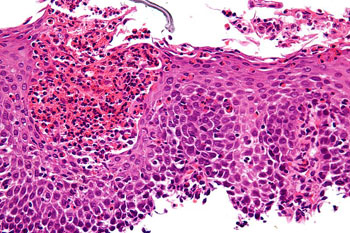Pathway Implicated in Development of Eosinophilic Esophagitis
By LabMedica International staff writers
Posted on 26 Apr 2016
Scientists have identified a protein whose dysfunction appears to be involved in causing the tissue damage in patients with eosinophilic esophagitis (EoE). The finding may lead to improved pathology analysis, diagnostics, and specific drug therapies for patients.Posted on 26 Apr 2016
In this disease eosinophils (type of white blood cells) accumulate in the esophagus, often causing difficult painful swallowing, nausea, vomiting, and poor growth. Researchers from the Cincinnati Children’s Hospital Medical Center (Cincinnati, OH, USA), led by Prof. Marc E. Rothenberg, had previously identified genetic differences associated with EoE patients that led them to focus on the CAPN14 gene, encoding calpain-14. In this new study, the team collected esophageal biopsies from EoE patients to investigate a possible role for calpain-14 in disease development. They exposed cells from the tissue biopsies to interleukin- 13 (IL-13) in order to mimic signals that may contribute to EoE development.

Image: A micrograph of eosinophilic esophagitis (EoE), H&E stain. Characteristic features are present: Abundant eosinophils—criteria vary; one common definition is: > 20 eosinophils/0.24 mm2; Papillae are elongated; papillae reach into the top 1/3 of the epithelial layer; Basal cell hyperplasia; > 3 cells thick or >15% of epithelial thickness; Spongiosis (Photo courtesy of Wikimedia).
IL-13 caused the cells to markedly (>100x) increase production of calpain- 14, which was found to regulate the protein desmoglein-1 (DSG1), a critical component of esophagus tissue. These molecular changes may be an early step in a process that leads to inflammation and scarring in the esophagus. Furthermore, epithelial cells overexpressing CAPN14 displayed impaired architecture, characterized by acantholysis, epidermal clefting, and epidermolysis. CAPN14 overexpression impaired epithelial barrier function.
These and addition results from the study demonstrate a molecular cellular pathway that contributes to T-helper type-2 responses in mucosal epithelium. The findings suggest that controlling the production or activity of calpain-14 may prevent development of EoE, making calpain- 14 a potentially valuable drug target.
The study, by Davis BP et al., was published April 7, 2016, in the American Society for Clinical Investigation’s journal JCI Insight.
Related Links:
Cincinnati Children’s Hospital Medical Center













